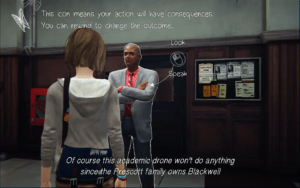For this week’s critical play, I will be writing about Life is Strange. Although I have never played the game myself from beginning to end, I have seen clips of its story and gameplay. Furthermore, I managed to play the first episode for free by downloading it from Steam on my computer.
The game was created by Dontnod Entertainment and published by Square Enix in 2015. Matching with this week’s theme, the game is primarily a mystery where players spend most of their time in conversation or wandering and searching around environments. And since Life is Strange mainly revolves around figuring out the truth behind in-game events and character motives, the game primarily serves a narrative type of fun.
The most notable formal element of Life is Strange is the ability to rewind time and redo an action or comment. This can be done almost anytime during gameplay, but the most important times are when choices will hav e significant effects on the future. This is usually indicated by a pop-up, as shown below.

I liked that the consequence icon is a butterfly. It is reminiscent of the butterfly effect, which states that small actions now will have huge impacts later. Thus, it is consistent with the concept of one of the main mechanics in the game. This feature is also useful for when the player wants to be perceived as good or likable by a character in the story, but has accidentally said the wrong thing. Usually, the optimal response is revealed after the mistake is made and the player must rewind time to choose the right option. Luckily, the correct option is also underlined to remind the player.

Still, the game is pretty linear. The player does not have too much freedom as they are moved from one storyline/episode to the next. Thus, Life is Strange contains an architecture where the player is constantly moving along a a series of arcs. There are no real times where the player is set into an interaction loop and is freely allowed to practice any skills. As a result, this creates an experience where players are continually digesting new informational content with little to no breaks. In a way, the game functions more as an expositional piece with many little interactive moments rather than a “traditional” game where players are improving a set of skills to accomplish a goal.
Still, delivering a story in this format is fun for when people want to experience an interesting narrative while doing low-stress work to feel like they are actively moving the plot forward. My main critique is that the player does not know exactly which choices affected major plot points in the story, such as some of the character deaths. This could be helpful is a notebooks or some guide were released upon completion in case players wanted to play again bit have different outcomes. Overall though, Life is Strange tells of a compelling story where players take an active role along every step of the way.


